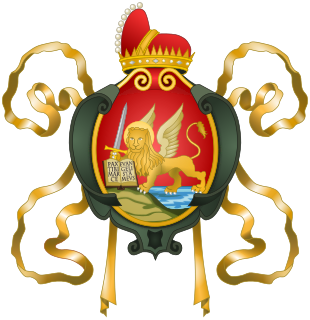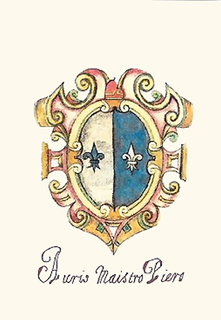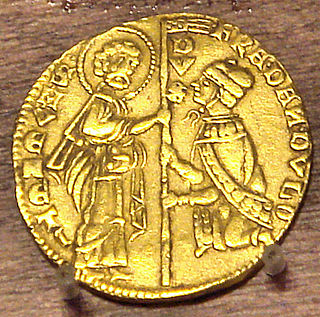
The Doge of Venice, sometimes translated as Duke, was the chief magistrate and leader of the Republic of Venice between 726 and 1797.

Marino Faliero was the 55th Doge of Venice, appointed on 11 September 1354.

Orio Mastropiero, forename sometimes rendered as Aurio and surname as Malipiero, was a Venetian statesman who served as Doge of Venice from 1178 to 1192.

Andrea Dandolo was elected the 54th doge of Venice in 1343, replacing Bartolomeo Gradenigo who died in late 1342.
Vitale Candiano was the 24th doge of the Republic of Venice.

Marino Morosini was the 44th doge of Venice. He governed from 1249 to 1253.

JacopoTiepolo, also known as Giacomo Tiepolo, was Doge of Venice from 1229 to 1249. He had previously served as the first Venetian Duke of Crete, and two terms as Podestà of Constantinople. During his first term, following the capture and mysterious end of Peter of Courtenay, Tiepolo acted as de facto ruler of the Latin Empire, negotiating treaties on behalf of the Empire with Egypt and the Seljuk Turks.

Giovanni Dandolo was the 48th Doge of Venice, elected late in his life on 31 March 1280, died on 2 November 1289. During his reign the first Venetian gold ducat was introduced into circulation.

Francesco Dandolo was the 52nd Doge of Venice. He ruled from 1329 to 1339. During his reign Venice began its policy of extending its territory on the Italian mainland.

Pietro Polani was the 36th Doge of Venice. He reigned from 1130 to 1148.
Giovanna Dandolo was a dogaressa of Venice by marriage to doge Pasquale Malipiero.
Giovanni Polani was Bishop of Castello, Italy, from 1133 to 1164. He was engaged in a long-running dispute over jurisdiction with Enrico Dandolo, the Patriarch of Grado.

The Diocese of Castello, originally the Diocese of Olivolo, is a former Roman Catholic diocese that was based on the city of Venice in Italy. It was established in 774, covering the islands that are now occupied by Venice. Throughout its existence there was tension between the diocese, the Patriarchate of Grado to which it was nominally subordinate, and the Doge of Venice. Eventually in 1451 the diocese and the patriarchate were merged to form the Archdiocese of Venice.
Enrico Dandolo was Patriarch of Grado, Italy, from 1134 to 1182. A member of a noble Venetian family, after his appointment he put the interests of the church ahead of all other concerns.

Dandolo was a patrician family of the Republic of Venice, which produced four Doges of Venice. The progenitor of the family was a merchant named Domenico. The family became more successful by the beginning of the 12th century.
Geremia Ghisi was a Venetian nobleman who in ca. 1207, following the Fourth Crusade, captured the Greek islands of Skiathos, Skopelos, and Skyros and became their lord, while his brother Andrea Ghisi conquered the islands of Tinos and Mykonos. Their sister or half-sister, Agnese, married Othon de Cicon, who became the lord of Karystos on Euboea.
The Podestà of Constantinople was the official in charge of Venetian possessions in the Latin Empire and the Venetian quarter of Constantinople during the 13th century. Nominally a vassal to the Latin Emperor, the Podestà functioned as a ruler in his own right, and answered to the Doge of Venice. The podestà was also officially known as Governor of One-Fourth and One-Half of the Empire of Romania and was entitled to wearing the crimson buskins as the emperors.














